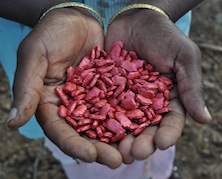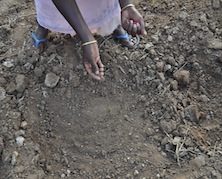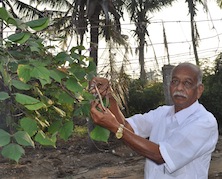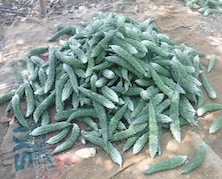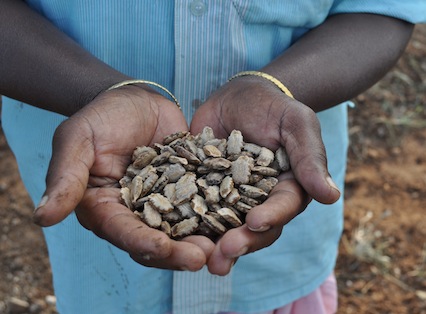| Vegetables | : | Bitter gourd, snake gourd and ridge gourd in 1 acre |
|
||||
| Irrigation | : | Drip irrigation | |||||
| Layout | : | Farm Yard Manure application in raised bed | |||||
| Row spacing | : | 12×14 feet | |||||
| Rabi season | |||||||
| Crop spacing | : | 5 feet | |||||
| Sowing | : | 2 or 3 seeds at horizontal position per hole | |||||
| Drip irrigation | : | 20 minutes/acre | |||||
| Ploughing | : | Yearly once | |||||
| Basal fertilizers | : | Farmyard manure, Poultry manure, vermicompost | |||||
| Insect protection | : | Using light traps, pheromone traps, Trichogramma parasitoid, herbal insecticide, Panchakavya, Jeevamirtham, Amirthakaraisal- 3G mix (garlic, ginger and green chilli) |
| Steps in Trellis based Vegetable cultivation
Mr. K.V.Palanisamy adopted the following practices to sustain the soil health, to give poison free food and to enhance the natural resources of land to produce higher yield and more income. |
||||||||||||||||||
| Ploughing:
Primarily the field is ploughed using 5 tine or 8 tine tractor plough. After the secondary plough, bunds are prepared with a row spacing of 12×14 feet in the North- South direction. Further rectification of beds and channels are done manually. About 9 tonnes of farmyard manure is applied to the field and a thin layer of soil is spread over it. Again 2 kg of Azospirillum, 2 kg of Phosphobacteria and 2 kg of Pseudomonas are mixed with 25 kg of cow dung or ash and broadcasted to the field. Vermicompost is applied and pit humps are raised to ¾ feet height to form pits for every 5 feet distance to facilitate drip irrigation. |
||||||||||||||||||
|
||||||||||||||||||
Irrigation
Irrigation should be done daily either in the morning or in the evening. The watering should also be carried out twice, if the temperature rises beyond 40°C. For an acre, 15-20 minutes of irrigation is ideal. Irrigation should be continued till the end of the harvest.
|
|||||
| Plant growth regulator
Manual weeding is followed on 18-20 days after sowing and the field is allowed to dry for two days. Jeevamirtham is prepared and mixed with 20 kg of neem cake extract and poured into the pits. To maintain the soil health, fishmeal, arappu powder +buttermilk mixture and neem cake or castor cake is applied at 15 days interval. On 70th day, 5 kg of farmyard manure is applied to each pit. This will increase the production of earthworm in the soil. At 20 days interval, panchakavya is applied regularly. |
 Setting up of light trap in bitter gourd field |
 Setting up of pheromone tap in coccinea field |
| Crop protection
Four light traps and 3 pheromone traps are placed in the field after 60 days of sowing.Early in the morning, the insects are removed from the pheromone traps and burried. For better flowering, arappu powder +buttermilk mixture is applied on full moon day. A mixture of neem oil, pungam oil with resin soap mixture is applied at 20 days interval. At alternated hot and cold period, a mixture of traditional cow buttermilk and unripened coconut water is applied. By using light and pheromone traps the mother insects are destroyed. Biopesticide @ 8-10 ml/ 10 litre of water is sprayed at 12-15 days interval. |
 Butter milk solution preparation at his field |
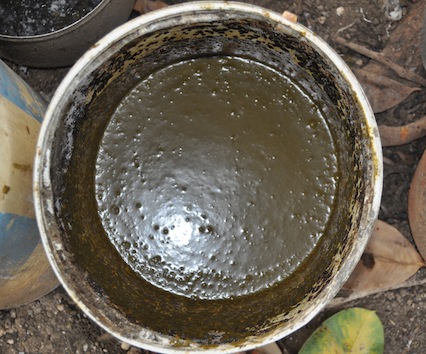 Panchakavya preparation at his field |
Mulching
Waste materials from kitchen is collected and applied to the pits to avoid direct sunlight and to maintain the soil moisture. Black plastic sheet can be spread on the field to reduce weeds and moisture loss.
Harvesting
|
The crop wise yield is mentioned below:
|
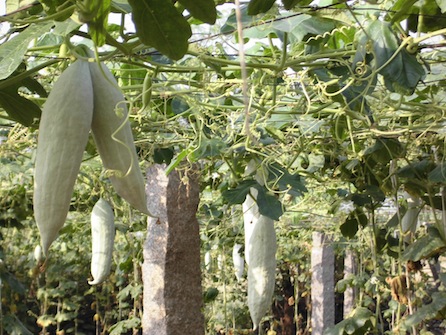 Field photo of organic Snake gourd |
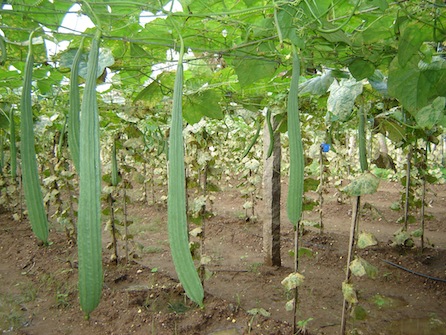 Field photo of organic Ridge gourd |
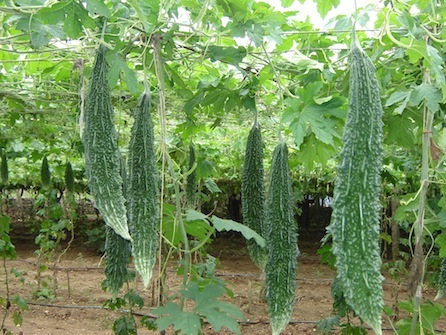 Field photo of organic Bitter gourd |
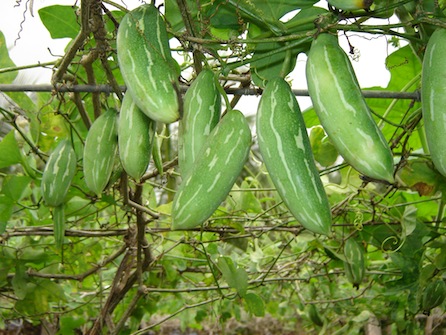 Field photo of organic Coccinea |
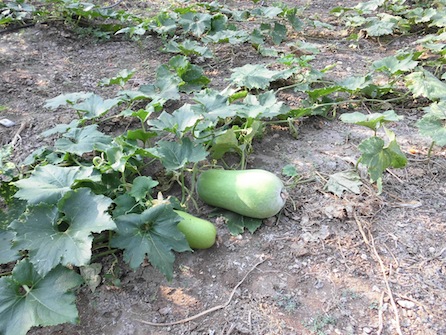 Field photo of organic bottel gourd |
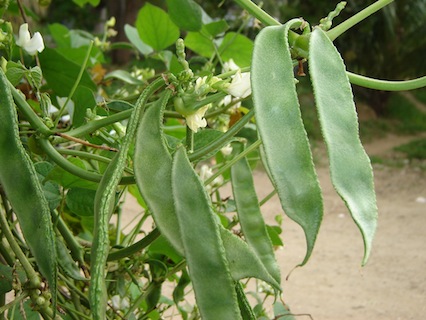 Field photo of organic Lab lab |
Marketing: The produce is sold based on market price. Proper post harvest practices and transport facilities helps to expand his market and get higher returns.
 Harvested coccinea in gunny bag ready to sale |
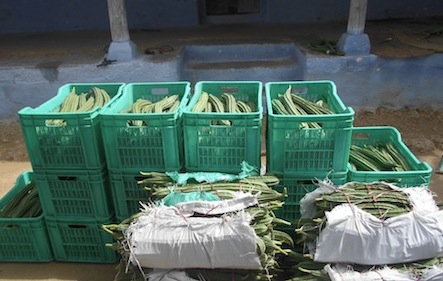 Bittergourd packed for marketing |
New strategies for higher vegetable production:
- Groundnut cake 10 kg, coconut cake 10 kg, cotton seed cake 10 kg, neem cake 10 kg are soaked in water separately and allowed to ferment for four days. Mix these solutions and add 1.5 kg phosphobacteria, 1.5 kg azospirillum and 1.5 kg humic acid into it. Spray this solution to the plants at 20 days interval to get more yield.
- Mix 200 ml of sour buttermilk and 100 g of Pseudomonas in 10 litres of water and spray this solution at 20 days interval.
- Spray 3G-solution (ginger, garlic and green chilly solution) at 20 days interval.
Cost of cultivation (per acre)
I. Trellis cost:
| Pillar cost:
Pillar height 8 feet, pillar-to-pillar distance 12.5 feet, pillar distance inside the fence 25 feet.
Cost of 1 Pillar = Rs.335 |
String cost
String for outside trellis (4 gauge)
|
|||||||||||||||||||||||||
String for inside trellis (8 gauge)
|
Netting cost for inside trellis (16 gauge)
|
Total Cost for trellis construction:
- Total string cost= Rs. 91,890/-
- Labour cost for trellis construction: Rs.25, 000/-
- Total trellis construction cost: Rs. 1,17,000/-
II. Drip irrigation cost:
| Number of pits per acre | = | 550 |
| 2 inch PVC pipe 240 feet- 12 length size | = | 40 kg |
| 1.5 inch PVC pipe 240feet – 4 length size | = | 10 kg |
| One kg | = | Rs. 53 |
| Total cost (50 kg x Rs.53) | = | Rs. 2650 |
| 16 mm lateral hose (780m x 4) | = | Rs. 3120 |
| 12 mm lateral hose (240m x3.25) | = | Rs.780 |
| 8 mm lateral hose (200 m x1.50) | = | Rs .300 |
| 16/8 mm T & 12/8 mm T (600 x1.30) | = | Rs. 780 |
| 8 mm tap (600 x1.00) | = | Rs. 600 |
| 2 inch ball valve (4 x125) | = | Rs. 500 |
| Other fitting cost | = | Rs.1000 |
| Total cost | = | Rs.10,000 |
- Trellis cost: Rs. 1,17,000
- Drip cost: Rs.10,000
- Total cost for trellis: Rs.1,27,000/-
Trellis: An amount of Rs.1,27, 000 is required for preparing trellis using pillar stone and fencing trellis including drip cost.
See More: https://agritech.tnau.ac.in/farm_innovations/farm_innovations_pandal_veg_e.html
Original link: https://tnau.ac.in/


